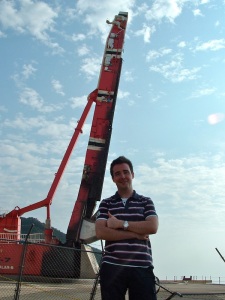This weekend marks the sixth anniversary of the launch of the Japanese/US/UK* satellite, Hinode. It was launched on the 22nd of September at 21:39 UT. But in Japan, where we saw it blast off, it was already daybreak on the 23rd, so that’s the anniversary I keep in my head…
 A younger me, at the launch rail in Uchinoura, a couple of hours after Hinode took to the skies.
A younger me, at the launch rail in Uchinoura, a couple of hours after Hinode took to the skies.I have a strong personal connection to this mission. I was a scientist-in-residence at ISAS and still am a so-called “chief observer” for the UK on its EIS spectrometer (don’t get excited: there are a lot of “chiefs” in Hinode nomenclature). I was in Japan from before launch, got to see it successfully “born” by a Mu-V rocket from Uchinoura, and then returned to ISAS to help out in the process of commissioning the satellite’s EIS spectrometer, getting the data to start flowing from the instrument, and learning how this mission actually worked.
It might sound odd to say that, because isn’t the working all written down in documents? Aren’t all the processes understood? Well, I heard an interesting line from Salman Rushdie’s memoirs this week:
“…when a book leaves its author’s desk, it changes”
The same is true, I think, of any substantial work. A mission is a living thing: just like a book, Hinode left its many authors’ collective desk and took on a life of its own. In the months and years that followed launch, we learned how this complex system interacted within itself, with us, and with the wider scientific world. Almost simultaneously, NASA’s STEREO satellites were launched and our perspective on the solar system changed again, and its scientists, engineers, and other staff will have their own stories to tell.
The experience of Hinode was profoundly life-changing, professionally but also personally, and I look on my time at ISAS and in Japan with great fondness. By chance, I recently found a video message I made, for (now fellow-blogger) amacrojot, on the night after I moved to Japan. It makes me chuckle to see the “pre-experience” me, hear his less-diluted accent, and think of of what was going to happen over the next three years there. The reason I bring this up is that science isn’t all just about contributing to the economic success of the countries involved, although it can’t help doing that. Science also gives you a much, much broader experience. You travel, you’re exposed to different ways of thinking, and for every frustrating problem or situation you encounter, you also come across one of the most surprising people who can solve or see the way around it. And space science has this collaborative international nature that produces these great moments so often.
Enough evangelising. I really just wanted to pay respect to all the people I’ve been lucky enough to work with on Hinode, and those who put up with me being away. The list is long, but you know who you are :o)
(*note the countries involved, Huffington Post… )
